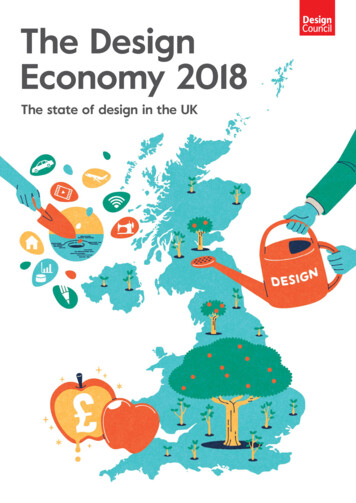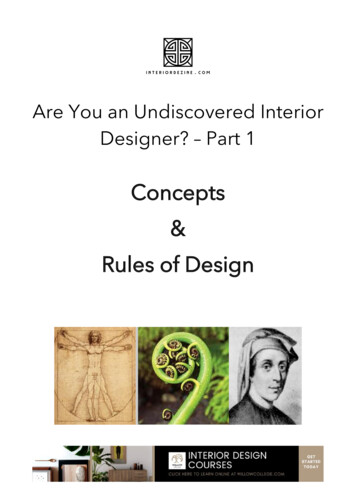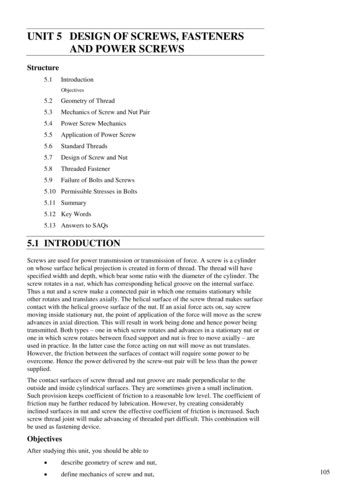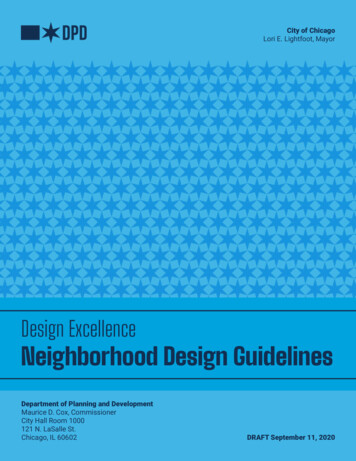
Transcription
Proceedings of the 2016 International Conference on Industrial Engineering and Operations ManagementKuala Lumpur, Malaysia, March 8-10, 2016The Design of QTrac: an automated Quality and Cost Management System forProjectsHannelie NelPost-Graduate School of Engineering Management, University of JohannesburgJohannesburg, South Africainformation@hannelienel.co.zaJan-Harm PretoriusPost-Graduate School of Engineering Management, University of JohannesburgJohannesburg, South Africajhcpretorius@uj.ac.zaAbstract - The value of Total Quality Management is demonstrated by the fact that quality products and service are non-negotiableas market-entry for organizations to compete globally. Quality costing is a measure of the efficiency of Total Quality Managementand the metric that companies employ to measure their gain in profitability from investment in quality management programs.Current financial accounting systems, however, are not designed to measure and report quality related data in a format that allowsinformed decision-making. Two companies, BIE International and PACE Services, combined their expertise in quality managementand cost engineering to design a quality and cost management system that measures and reports quality management and cost dataand information. The program is called QTrac for Projects and Manufacturing and is designed as a quality decision-making andcost management system for the project and manufacturing sectors. The objectives of this paper are to present the design strategyof QTrac in response to the critique and limitations of existing quality cost and accounting methodologies.Keywords quality costing, QTrac, quality management, projectsI.INTRODUCTIONThe value of Total Quality Management in industry is undeniable in that high quality is non-negotiable as entry to marketand opportunity for organizations to compete globally. Quality costing is the metric by which companies measure their gainin profitability and cost savings from investment in quality management programs, products and services. Current financialaccounting systems, however, are not designed to measure and report quality related data in a format that allows informeddecision-making. In response to this challenge, two companies, BIE International and PACE Services, combined their expertisein quality management and cost engineering to design a quality management and cost system called QTrac: a system to managequality activities and costs in Projects and Manufacturing. QTrac informs decision-making in quality management and qualitycosting to achieve risk mitigation, cost reduction and continual improvement.In 2013 PricewaterhouseCoopers reported that capital project and infrastructure spending is expected to total more thannine trillion dollars by 2025 and that the economic return generated for every dollar spent on a capital project lies between fiveand twenty five percent [1]. That economic return, however, is eradicated by poor quality in project planning and execution.Furthermore, KPMG found that only thirty-one percent of projects came within ten percent of their original budget and fiftythree percent of the companies surveyed experienced one or more underperforming projects in the past year [2]. The maturityof projects and project management is illustrated by the iron triangle in Figure 1 which shows the inter-relationship of quality,cost and schedule in a project. Schedule and project costs are often unwittingly favoured at the expense of quality and thisimbalance will continue to exist as long as the real cost of quality remains hidden among total project costs. IEOM Society International
Proceedings of the 2016 International Conference on Industrial Engineering and Operations ManagementKuala Lumpur, Malaysia, March 8-10, 2016Fig. 1. The iron triangleThe reasons for the hitherto unsuccessful development of an automated quality and cost management system for projectsare two-fold. For a quality cost system to be considered a substantive and trusted decision making tool, it is important thatthese challenges are confronted and addressed both practically and sensibly. The first challenge is that quality costing, as atool for continual improvement and cost reduction, is contested during implementation due to its apparent subjective, invasiveand laborious nature. QTrac addresses this challenge in its marketing and design strategy by several interventions inter aliathat the software will only be released to mature quality clients during its initial implementation. This strategy ensures that theclient understands the value of quality costing and will consequently implement all necessary organisational structures,processes and systems to ensure effective operation of QTrac. The client will also be willing to manage the change associatedwith its implementation and support the required changes with relevant quality cost training. Secondly, the programme willbe tested during its’ first release to address all the potential queries that may arise with future implementation and integrationwith existing systems. Marketing of QTrac, however, is not the focus of this paper and will be addressed by a comprehensivego-to-market strategy and a separate publication.The second challenge is that quality costing is neither a traditional financial accounting system nor a classic cost allocationmethodology. Quality costing is a hybrid costing system that not only extracts and captures direct and hidden quality costsfrom current accounting systems and cost allocation methods; but also sources the required data by its own design. Theobjectives of this paper are therefore to present a critique of current quality costing models employed in industry, and to respondto the critique with a discussion of the high-level design and costing philosophy of QTrac.II.CRITIQUE OF CLASSIC QUALITY COSTING MODELSA. Critique of Classic Quality Cost Models: an overviewIn 1986 Deming argued that measuring quality costs is a waste of time due to hidden and unmeasurable costs and theconsequent inaccurate reflection of the process state. Schiffauerova and Thomson [3], however, maintain that customerrequirements can only be met through continuous improvement if the cost associated with achieving quality is considered.These opposing views inform the current debate on the extent to which quality costing should be employed by firms in strivingfor quality improvement, and whether an optimal point of investment versus benefit is achievable - the traditional view beingthat better quality demands higher cost and vice versa [4]. IEOM Society International
Proceedings of the 2016 International Conference on Industrial Engineering and Operations ManagementKuala Lumpur, Malaysia, March 8-10, 2016Current quality cost models may be classified in two primary categories: the most widely known model is the preventionappraisal-failure (PAF) model as defined in the British Standard BS 6143-1 of 1992 [5]; and the process quality cost model.The PAF model may include or exclude opportunity or intangible costs where these costs can only be estimated [6]. Examplesof intangible costs include profits not earned due to lost customers and reduced revenue owing to non-conformances.In 1979, Philip Crosby modified the PAF classification and presented cost of quality as the sum of the price of conformanceand the price of non-conformance - known today as the process cost model and applied in quality costing by Marsh in 1989[7]. Distinguishing features of the process cost model are that it focuses on processes rather than products, and that it’s asimpler cost model than the PAF model in its identification and allocation of cost elements.Despite the PAF model and the process cost model being the two main approaches to measuring cost of quality (CoQ),neither approach provides an adequate method to allocate overheads to CoQ elements [3,6]. Activity-based costing (ABC) isused by selected authors to overcome this shortcoming [8,9]. Under ABC, accurate costs for various objects are achieved bytracing and assigning resource costs (including overheads) to products (ibid.). ABC, however, does not consider process costsor costs external to the process and therefore is not considered a CoQ model. In 1998, Tsai proposed an integrated ABC-CoQframework as demonstrated in Figure 2 [10]; and ten years later Liu, Cui, Meng and Pan used this model to propose andsimulate a CoQ accounting system [11]. Figure 2 proposes ABC consisting of two dimensions: the cost assignment view andthe process view. Cost objectives include products, product lines, processes, customers, channels and markets – and create theneed for activities. Activities, in turn, create the need for resources which may include people, machines, facilities and utilitiesas example in the manufacturing sector.Cost Assignment ViewResourcesResourceDriversProcess ty DriversCostObjectsFig. 2. Two-dimensional ABC-CoQ framework(adopted from Tsai, 1998:728) IEOM Society International
Proceedings of the 2016 International Conference on Industrial Engineering and Operations ManagementKuala Lumpur, Malaysia, March 8-10, 2016Despite the recognized value of quality costing, CoQ systems are not critic-free and some quality practitioners view qualitycost programmes as impediments, rather than contributors, to quality [12,13]. Angell and Chandra [14] and Dale and Wan [15]describe some of the challenges experienced by firms in implementing quality costing including inter alia an inappropriatecorporate culture and resistance to change; lack of critical support of cross-functional teams; lack of resources with thenecessary experience and skills; the incorrect application of quality costing methodology; and errors in data collection. Thelatter was confirmed in an earlier study by Dale and Plunkett [16] where wide differences between the quality costing modelsand real world data were found.Whether a company chooses to implement the PAF model or the process cost model, the chosen method must be tailoredto suit a company’s requirements and support continual improvement [15, 17]. Ultimately, the success of implementation ofany chosen quality cost model is fully dependent on executive support and leadership [18, 19, 20].B. The PAF ModelJoseph Juran initiated the concept of economies of quality and the graphical form of the cost of quality model in 1951 [3].Later, in 1956, Armand Feigenbaum proposed the classification of quality costs into the categories of prevention, appraisal andfailure costs – generally referred to as the PAF model [21] – and since the time of classification the PAF scheme has beenalmost universally accepted for quality costing [6]. Consequently, Juran proposed an optimal level of quality based on therelationship between quality costs as indicated in Figure 3 [22]. Feigenbaum’s classic CoQ model assumes a trade-offrelationship between prevention and appraisal, and failure costs, where the optimal level of quality exists at the intersection ofthe cost curves to produce a minimum total cost of quality. The premise of this theory is that a hundred per cent conformanceto quality costs too much and is therefore impractical and unachievable.Quality costs (R)The traditional model, however, does not account for technological improvements or organisational learning, andcontradicts the principle of continual improvement. If continual improvement is required in an organisation, no economic levelof quality exists and spending on prevention activities can be justified if necessary and supportive of the organisation’s strategicobjectives [23].Total qualitycostsInternal and externalfailure costsPrevention andappraisal costs0Quality of conformance (%)Fig. 3. Classic view of quality costing(adopted from Juran, 1962) IEOM Society International100
Proceedings of the 2016 International Conference on Industrial Engineering and Operations ManagementKuala Lumpur, Malaysia, March 8-10, 2016Quality is often viewed as an attribute with a fixed unit cost [24]. This static formulation of quality, however, is challengedby Freiesleben [12] and Modaress and Ansari [4]. They respectively question the exponential increase of prevention andappraisal costs in Figure 3 and the resultant cost differentials. Freiesleben [12] argues that investment in prevention is subjectto diminishing returns because not all root causes of a problem can be detected with the first effort. Organisational learningand technological development may also contribute to quality cost differentials in that the problem detection and solvingprocess is mastered over time - thereby making for a more efficient organisation and requiring less investment in appraisal(ibid.). The impact of these developments on quality costing is illustrated in Figure 4 and indicates that the quality cost ofdetecting root causes is initially high (q1). As technology development in the company increases from C1 to C5, the cost ofconformance and the cost of detecting root causes decrease accordingly.costs per unit of good producttechnological progresslearningdetection of root causesC1C2C3C4C5q1 q2 q3 q4 100%conformance to qualityFig. 4. Development of the costs per unit of good product over time(adopted from Freiesleben, 2004:965)Modaress and Ansari [4] agree that a learning curve exists in organisations and that production and production related costscan decline as a result of learning from experience. The traditional quality cost model with exponential increases in preventionand appraisal presupposes a company with a poor quality level or a company just starting to implement a quality improvementprogramme [12, 6].In modern quality management, the traditional inspection mode as a measure of appraisal is replaced by the ʺestablishmentof an effective and relatively inexpensive monitoring system, reflecting the insight that quality cannot be guaranteed by everincreasing inspection, but only by keeping the production
Quality costing is a hybrid costing system that not only extracts and captures direct and hidden quality costs from current accounting systems and cost allocation methods; but also sources the required data by its own design.











